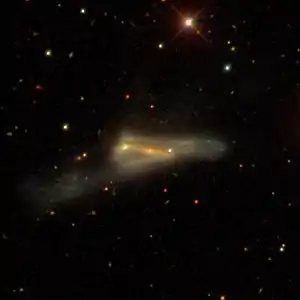NGC 523
NGC 523, also known as Arp 158, from the ARP catalog is a spiral galaxy located in the constellation Andromeda.[1] It was discovered separately by William Herschel on 13 September 1784, and by Heinrich d'Arrest on 13 August 1862. d'Arrest's discovery was listed as NGC 523, while Herschel's was listed as NGC 537; the two are one and the same.[4] John Dreyer noted in the New General Catalogue that NGC 523 is a double nebula.[1]
| NGC 523 | |
|---|---|
 NGC 523 as seen on SDSS | |
| Observation data (J2000[1] epoch) | |
| Constellation | Andromeda |
| Right ascension | 01h 23.3m 00s[1] |
| Declination | +34° 02′ 00″[1] |
| Redshift | 0.0159[2] |
| Helio radial velocity | 4758 +/− 4 km/s[3] |
| Galactocentric velocity | 4904 +/− 7 km/s[3] |
| Distance | 219 million light years away[2] |
| Apparent magnitude (V) | 12.7[2] |
| Apparent magnitude (B) | 13.5[1] |
| Surface brightness (specify) | 13.2[2] a |
| Characteristics | |
| Type | SBc/P[2] |
| Apparent size (V) | 2.5 feet x 42 inches[2] |
| Other designations | |
| NGC 537, 4ZW 45, Arp 158, CGCG 521-22, IRAS 01225+3345, MCG 6-4-18, PGC 5268, UGC 979, V V 783[2] | |
In September 2001 a type Ia supernova, SN 2001en was discovered in NGC 523.[5]
References
- Frommert, Hartmut. "NGC 523". spider.seds.org.
- Rojas, Sebastián García. "Galaxy NGC 523 · Deep Sky Objects Browser". DSO Browser.
- "Your NED Search Results". ned.ipac.caltech.edu.
- "New General Catalog Objects: NGC 500 – 549". cseligman.com.
- Bishop, David. "Supernova 2001en in NGC 523". Rochester Astronomy.org. Retrieved 21 October 2018.
External links
 Media related to NGC 523 at Wikimedia Commons
Media related to NGC 523 at Wikimedia Commons- NGC 523 on WikiSky: DSS2, SDSS, GALEX, IRAS, Hydrogen α, X-Ray, Astrophoto, Sky Map, Articles and images
- SEDS
This article is issued from Wikipedia. The text is licensed under Creative Commons - Attribution - Sharealike. Additional terms may apply for the media files.
